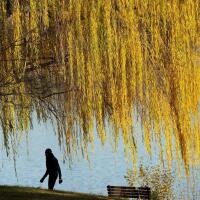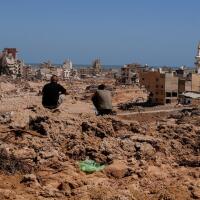Boyle Heights 'Resilience Hub' Responds to Climate Change With Social Change

This article was produced by Capital & Main. It is co-published here with permission.
East of downtown Los Angeles in late June, on the first day of the first heat wave of the summer, the Boyle Heights Arts Conservatory (BHAC) is a cool 74 degrees inside. Much of California is under an excessive heat warning; triple digits are expected in the nearby foothills of Los Angeles, Ventura and San Bernardino counties. Residents will get sick in the heat as will the people working outside, whether in construction or farm fields. But life continues uninterrupted at the BHAC.
Later in the afternoon there will be a pair of art classes for teenagers — singing for musicals and intro spoken word. The regular broadcast from the low-power FM station in the back, KQBH 101.5, will bring in the usual crowd of community members — kids, teenagers, young adults, adults and elders. Intuitively, this place has become safe for them all.
The BHAC is a model "resilience hub," a place meant to provide shelter and coordinate support in the event of an emergency like excessive heat. Though its mission is professional arts and media career training, the conservatory has collaborated with local government, public utilities, the American Red Cross, the U.S. Green Building Council Los Angeles and Climate Resolve to help the neighborhood adapt to climate change, including deadly local heat, by providing resources and leadership.
We were a resilience hub before we were designated a resilience hub because we're grassroots, community engagement.Stephanie Monte, Programs Manager, Boyle Heights Arts Conservatory
"We were a resilience hub before we were designated a resilience hub because we're grassroots, community engagement," said Stephanie Monte, conservatory programs manager.
In California, hotter temperatures are killing more people annually, especially those with cardiovascular and respiratory health concerns, and increasing hospital visits among those with diabetes. It is adversely impacting pregnant women and their babies, according to the California Office of Environmental Health Hazard Assessment. Heat-related deaths, hospitalizations and emergency room visits are highest among Black people in California.
A regional study of the Southwest found the greatest temperature gap between the wealthiest and poorest neighborhoods right here in California's cities — nearly five degrees hotter in low-income neighborhoods on extreme heat days. The same study found temperature disparities within Latino neighborhoods in California were greater than those in urban parts of Arizona, Utah, New Mexico, Colorado and Texas.
Heat has a more severe impact on low-income communities of color, urban and rural. Yet heat death and heat-related illness can be prevented, according to the Centers for Disease Control and Prevention. Both University of California, Los Angeles and University of Southern California have published guidance to better protect the state's most vulnerable from excessive heat.
In May, California, a leader in the development of resilience centers, announced nearly $100 million in grants as part of a $270 million investment to ease the impact of extreme heat and climate change. Suddenly, resilience centers and hubs are emerging in the ashes of Northern California communities razed by wildfire. Meanwhile, near the Conservatory, Green Meadows Recreation Center in South Los Angeles is getting retrofitted as a center.
"We will start seeing more resilience hubs come up," said Andres Rodriguez with Climate Resolve. "What makes [them] important is the community. Having people involved in the design is key."
Summer heat leads people to seek relief where they can find it: malls, pools, churches, libraries and, in extreme circumstances, emergency cooling centers. But cooling centers are both stigmatizing and uninspired: No one wants to sit on a folding chair on a basketball court on a Saturday night. Enter resilience hubs.
A resilience hub is a trusted community space that delivers services while also built to withstand emergencies and climate change. Hubs offer community services and programming, the ability to communicate during an emergency, a backup power supply and a plan to operate regularly, during emergencies and post-emergency recovery.

The Boyle Heights Arts Conservatory is located on the 2700 block of East Cesar E. Chavez Avenue in Boyle Heights, a dense Chicano enclave east of downtown. The building will be 100 years old next year. In the front is Brooklyn Avenue Pizza Co., a wood-fire pizza oven kitchen. Upstairs is the Paramount, a historic live-music venue. All of which is the vision of building owner and businessman Frank Acevedo.
To get to the BHAC, you enter through a long corridor that tells the story of the building. To the left down the hallway hang 28 framed black and white portraits of musicians who performed at The Paramount, among them Little Stevie Wonder, Celia Cruz, Don Tosti, Tito Puente and Lalo Guerrero. The opposite wall is a mixed media mural of the hall's punk iteration as the Vex. First wave California punks Black Flag, Social Distortion, Adolescents, Suicidal Tendencies and the Plugz played upstairs. Layered on top are icons that reference the multicultural history of the neighborhood. Tucked alongside the fliers are images displaying the neighborhood's Chicano history and the logo of the Bakery and Confectionery Workers International Union of America, the L.A. local of which was a radical Jewish cooperative that built the building. (Upton Sinclair once lectured there.)
In the fall of 2019, then-Los Angeles Mayor Eric Garcetti helped facilitate a series of meetings between the BHAC and the American Red Cross, Los Angeles Department of Water and Power, the U.S. Green Building Council Los Angeles and Climate Resolve. The organizations were impressed with the respect held by the BHAC within the community.
"Resilience is through a local, trusted partner," explained Ben Stapleton, executive director of the U.S. Green Building Council Los Angeles. "It's not a government mandated location designated without community input."
Together, they learned about unique, local community needs that had to be considered in the event of rolling blackouts or disruption to the power grid. Many people in the neighborhood take medication that must be refrigerated. Some residents rely on medical equipment that requires electricity and charging. Local nuances are important.

"Not all neighborhoods are impacted by climate change the same," said Rodriguez. "Everyone will have to adapt differently; programming and emergency operations will all be different. It's not a one-size-fits-all model."
The various groups assessed the century-old building and how programming might continue to operate in the event of an emergency.
The restaurant and club had to reduce its reliance on the grid. Solar panels were installed with the ability to store backup energy. A cool roof was created. Backup generators went in. With the mounting movement away from gas-burning stoves, a wood-fire kitchen seemed ideal. The radio station could operate as an emergency broadcast station, with a signal reaching across the L.A. basin. The BHAC has hosted CPR training. Acevedo and the group are currently assessing water system options, including filtration and storage independent of commercial water providers.
"If we do this, we can serve the community in more ways than what we already do," Acevedo said. "We are able to be a place that, in the event of an emergency, can be a resource. This is a place where people can still cook; where people can gather; where people can be safe."
In the event of an emergency, or a disruption in resilience parlance, Acevedo estimates the building can operate for a week and serve 150 people daily. A crisis that transforms it into an emergency center should be rare. But lesser threats, like heat waves and hazardous air brought by fires in the foothills, are not simply regular occurrences in Los Angeles: They are now expected. We call it fire season.
While the BHAC's mission is to provide career development in the arts to a community historically denied such investments, the programming reflects basic community needs. Food, clothes, shoes and school supplies are regularly distributed for free. Programs, such as Cartoons & Cereal, create opportunities for whole families to become familiar and comfortable with staff, instructors and resources.
In any given week, more than 250 people come through the center. That includes more than 60 employees, more than a dozen youth interns, upwards of 100 youth participants in classes and workshops as well as the 80 or more volunteers who host radio programs on KQBH 101.5. In addition, the BHAC offers programming for justice-impacted youth in juvenile camps and halls, who are encouraged to continue programs onsite when they return to the community. Then there's the indirect impact: Every one of those people has families and friends who are now more familiar with the BHAC. The impact spreads beyond the borders of this Eastside neighborhood. The center's doors are open to everyone, stresses Executive Director Carmelita Ramírez-Sánchez.

"Many people, especially our elders, just need a space to be cool," said Ramírez-Sánchez. "Sometimes people just want to be in community. Sometimes it's just 'Let me sit somewhere' because it's just that hot. You can sit in a gym or a cooling center and not be doing anything. We find that having something for participants to do really does make a difference for most of us."
I visited the BHAC on Friday, June 30. Five days later, on July 5, I spoke with Carmelita Ramírez-Sánchez. In that short span, Earth experienced its hottest day in recorded history. I'll be back in a few days, this time to take my daughter to a podcast recording class. We'll be there for programming. But we'll also benefit from a cool building set to 74 degrees. And we'll know that if anything happens, we can come back to the BHAC. That's more than just cool. That's resilience.
Copyright 2023 Capital & Main










